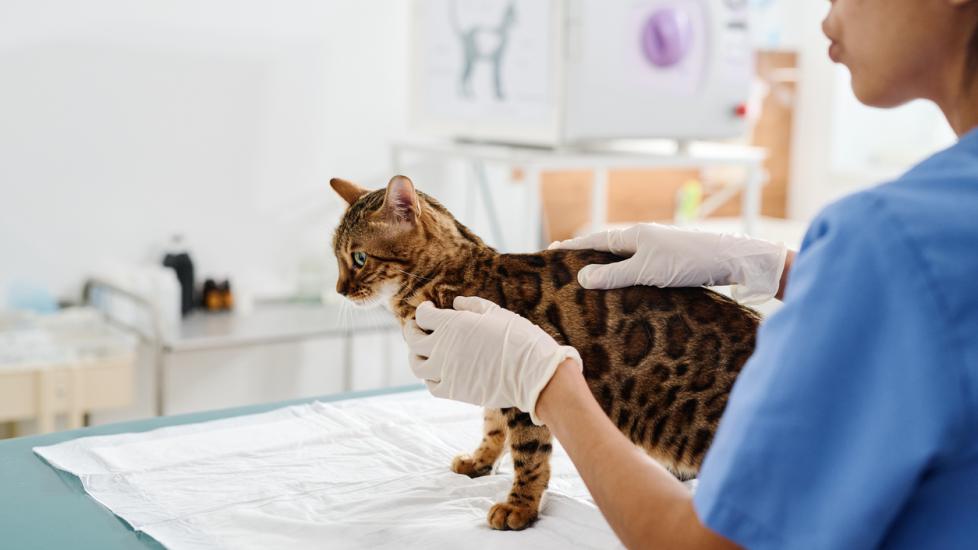Basal Cell Tumor in Cats
What Is a Basal Cell Tumor in Cats?
A cat’s skin, or epidermis, is made up of several layers. The bottom layer contains basal cells, which are responsible for producing new skin cells. A basal cell tumor is an abnormal growth and proliferation of these cells, their associated hair follicles, or sweat glands. Basal cell tumors are the most common type of skin tumor for cats, occurring in about 25% of all cases.
Although extremely rare, malignant basal cell tumors, also called carcinomas, grow in the area where the tumor is located and spread, or metastasize, elsewhere in the body.
Fortunately, most basal cell tumors in cats are benign, do not spread, and are easy to remove.
Symptoms of Basal Cell Tumors in Cats
Because basal cell tumors occur on the skin, the most noticeable sign will be a growth somewhere on your cat’s body. They can occur anywhere, but have a higher tendency to be found on the head, neck, back, or feet.
They often appear like a single, firm, hairless, sometimes ulcerated mass that may arise from a stalk or be freely moveable. Although they vary in size, they are often small, usually less than a few centimeters in diameter. In cats, they can range in color from gray to black. They can also at times be filled with fluid.
Causes of Basal Cell Tumors in Cats
Basal cell tumors are an abnormal and uncontrolled growth of basal cells. In humans, there is a correlation between UV light (sun damage) and the development of basal cell tumors, and this relationship is suspected in cats as well, but has not been confirmed.
Many factors, from chemical and toxin exposure to genetics, have been considered, especially since the tumors occur more commonly in older cats and in domestic medium- and long-hair breeds such as Persians, Angoras, and Himalayans.
How Veterinarians Diagnose Basal Cell Tumors in Cats
A physical exam is performed to locate a basal cell tumor and to determine its size and the extent of surgery required for removal. Your veterinarian may want to perform an FNAC (fine-needle aspiration cytology) of the mass. A small sample of the tumor is collected with a needle, then submitted for analysis. The test, generally non-invasive and minimally uncomfortable, is often performed bedside in the clinic.
If FNAC results are inconclusive, your veterinarian may elect to remove a piece of the tumor (biopsy) to send out for analysis or to remove the entire tumor, which should also be sent for analysis to ensure its complete removal and confirmation of basal cell tumor.
Prior to any anesthesia and surgery, your veterinarian may recommend a blood profile to review the cat’s kidney and liver function.
Treatment of Basal Cell Tumors in Cats
The treatment of choice is surgical removal of the entire tumor, then microscopic examination of the tissue for diagnosis. Successful removal of the tumor with clean margins almost always results in a good long-term prognosis.
For smaller tumors, cryotherapy (liquid nitrogen is used to freeze off the tumor) may be an option. Some pet parents may elect not to have a benign tumor removed. In that case, you will need to monitor the tumor and report any changes in size or appearance to your veterinarian.
Recovery and Management of Basal Cell Tumors in Cats
Fortunately, basal cell tumors rarely metastasize to other organs. Once surgically removed, they have an extremely rare incidence of growing back. So the prognosis is usually excellent! However, malignant tumors can be locally aggressive and may require more extensive surgery for the same type of prognosis.
As smaller masses are easier to remove surgically and have less inherent risk of complications, consult with your veterinarian at the first sign of any type of growth on your pet.
Once released from the clinic, your cat will most likely be feeling like their normal self in no time; however, expect a few weeks for a full recovery and getting back to their normal routine, as sutures require some time before they can be removed. Fortunately, just because your cat develops one basal cell tumor doesn’t mean they will develop more in the future.
Featured Image: iStock.com/shironosov
